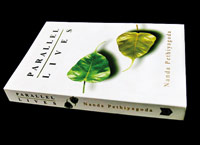Two women; two lives
View(s):Reading Parallel Lives, the story of two women from contrasting social backgrounds I kept wondering if it was possible for two such women, Namali from the caste-ridden Kandyan aristocracy, and Podi Menika from the village below the walawwa, born to the padu caste, to achieve the kind of relationship that the writer has us believe. After all, Podi Menika did not even have the right to her name – call her Podi, grandmother admonishes!
But the writer assures us that the companionship matured with age and experience with the two women supporting each other in every crisis in their lives, harmoniously.
But as we know parallel lines never meet and at the end of the day it is Podi who brings the coffee to the Hamu!
In tracing their lives the writer gives us a word picture of the convention-bound lives of people living hemmed in by those green fields and sparkling waterfalls of beautiful Kandy.
The narrative digs deep in to the past, at times mixing autobiographical details with fiction. Characters are fine drawn and well rounded, life-like portrayals of tradition and convention-bound people, often revealing the combination of wealth, social and caste distinctions.
The attitude to those of a lower social strata or of lower caste in the social ladder comes through, whether they are people whom the writer knew or figments of a fertile imagination.
These also come through at crisis moments as when a suitor for Namali is being sought. They come to life to the extent that the reader does not know one from the other, all of which contributes to an absorbing read.
There is a strong influence of Buddhist thinking pervading the narrative. Simple routines and attitudes ingrained in the minds of the characters are a tribute to their association with the word of the Buddha from an early age.
They enhance certain situations in the narrative and give a sense of reality to conversations and discussions. But there are serious issues of the prevalence of spirits and interpretations of birth and death, conversations with the departed, which are alien to Buddhist metaphysics.
In amassing details, sifting and arranging them in line with the events in the narrative, the writer has kept a keen eye on relevant details, meticulously researched and presented beautifully crafted into the details of the story so that they stand out not as extraneous embellishments, but as part of the whole.
This I find is the strength of the narrative and this writer’s real achievement.
Journeying into the past as it does in this narrative is fraught with emotion and recriminations, or it can be an oasis of happiness and pleasure.
But we know that memory is fickle and often blocks out the past. There are many instances when this has happened as in the neo Nazi claim that the pogrom against the Jews never happened during the Second World War!
The role of memory in creative writing has become crucial today, so much so that in the international literary arena it has become the subject of serious study in the last couple of decades.
In Parallel Lives, the writer has explored this subject successfully in recreating her experiences, both in the fiction and autobiographical sections, quite in line with the oft quoted expression of memory that ‘memory is like a sieve where the subject gets filtered and strained.
It is tied to time, history and social change. It is never completely free; it records, evades and brings silences…’
Parallel Lives will be launched today, February 14.
 Book facts: Parallel Lives by Nanda Pethiyagoda. Reviewed Book facts: Parallel Lives by Nanda Pethiyagoda. Reviewed by Vijita Fernando. Price: Rs. 1,500 |


